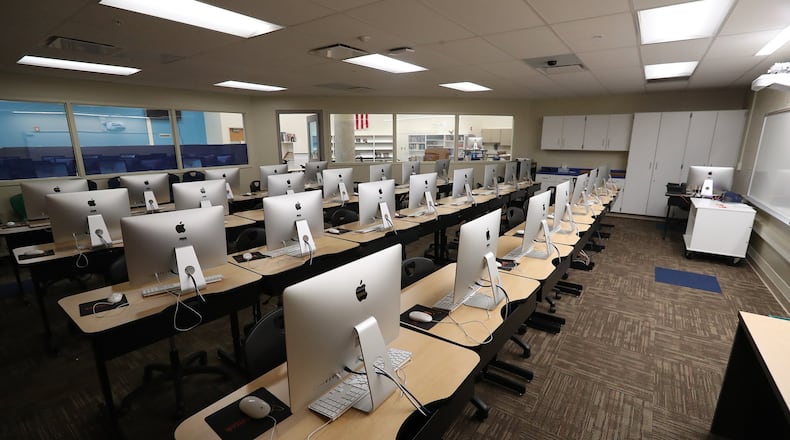Local public school districts have allowed families to choose whether their students learn in-person or from home this school year as the COVID-19 pandemic continues. Many schools have reported 10% to 30% of students choosing to learn fully online this fall. Adding in the schools that have shut down in-person classes completely, there are hundreds of thousands of Ohio K-12 students learning online.
Some local school districts argued against administering state tests in general this year. That included Oakwood, which regularly scores among the state’s highest achievers.
“There are many reasons we find no value in state testing this year, including lack of participation, preparation, the emotional state of our students, (student growth) cannot be calculated, unreliable state report card data, frustration of teachers and the unrealistic requirements for graduation,” said Kimbe Lange, Oakwood’s director of curriculum, instruction and assessment.
Centerville Superintendent Tom Henderson said, “I wonder if it is really in the best interest of our students” to take the state tests. He said time and focus should be spent on moving students forward academically, renewing relationships and trying to establish a sense of normalcy for students in a turbulent year.
State, federal input
Most Ohio students take state reading and math tests each spring from third to eighth grade, science tests in fifth and eighth grade, and end-of-course exams in seven subjects across their high school years.
Of those 21 tests, 17 are federally mandated. Some have suggested president-elect Joe Biden’s administration would offer testing waivers to states, like in 2020, given all the interruptions in the school year due to COVID-19. Biden said he will nominate Miguel Cardona as his secretary of education, but they have not made any announcement on waivers.
The leading Democrats on the U.S. House and Senate education committees, Rep. Bobby Scott and Sen. Patty Murray, released a joint statement saying 2021 state testing should go forward. They called it “a moral imperative,” suggesting that without it, “parents, educators, and policymakers would have zero data on the scope of learning loss” this school year.
Teachers unions have tight relationships with Biden, and they disagree, saying state-level tests should be canceled this year, and schools can use data from their internal diagnostic tests to measure learning.
A bill calling for Ohio to pursue a testing waiver had some legislative support in December, but never made it to a full vote. State school analysts say last-minute changes by the legislature are still possible before Ohio’s testing window opens March 22.
Local school responses
Troy Schools Superintendent Chris Piper specifically addressed testing for students who have been learning from home.
“Students who have families with serious pre-existing health conditions should not be forced to come to school solely to take a state achievement test,” Piper said. “We are in the middle of a global pandemic and they are concerned that they may expose their families to a potentially life-threatening disease.”
The Ohio Department of Education guidance agrees with Piper in a sense, saying schools should “first and foremost” be attentive to student and staff safety, adding that “parental determination relative to safety also should be considered and respected.”
But Piper pointed out that students who decide not to take the tests count as zeros in a key state academic measure called “performance index.” While that index will not be used to penalize schools in most ways for 2020-21 results, a low 20-21 performance index could make a school’s students eligible for EdChoice private school vouchers in the future.
“As far as what is currently written with regard to EdChoice and how the accountability ends up playing into the school eligibility, our teams haven’t had a chance to fully walk through step-by-step how that’s going to look yet,” Ohio Department of Education spokeswoman Mandy Minick said Wednesday.
In Oakwood, Harman School Principal Sarah Patterson said parents of remote students won’t send their kids to school for testing unless they’re separated from other students. She said that would require additional space and staff that’s not available given social distancing requirements.
Smith Elementary Principal Chrissy Elliott said spring 2021 testing won’t measure annual growth because students weren’t tested in spring 2020. Meanwhile Chad Aldis, Ohio vice president for the Fordham Institute, said 2021 testing would be valuable because it would set a new baseline after skipping last spring’s tests.
Brookville Superintendent Tim Hopkins said the small number of remote-learning families in his district who had to come in for fall state testing handled it well. He said spring testing, with more students involved, “will surely hold more challenges,” in part because schools don’t know how bad COVID spread will be in their communities two months in advance.
But Hopkins said the question of whether the state tests have value goes far beyond this year’s COVID-related complications. He warned that too often, state test results have just been used to rank schools against each other, despite community gaps driven by social and economic factors.
“When testing is used to support, direct and drive instruction, there is value,” Hopkins said. “If we are leaning into (questions like) what modes of instruction have shown best learner outcomes? Where have the effects of COVID left curricular gaps for students? How do we support children post-COVID-classroom? Then yes, there can be value to state testing this year.”
About the Author

